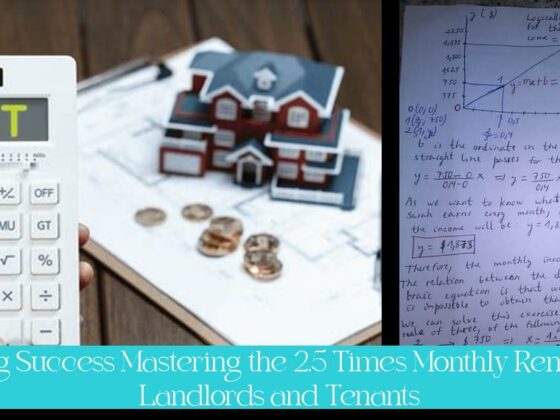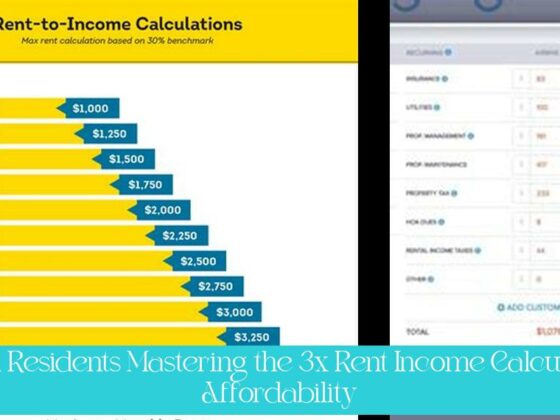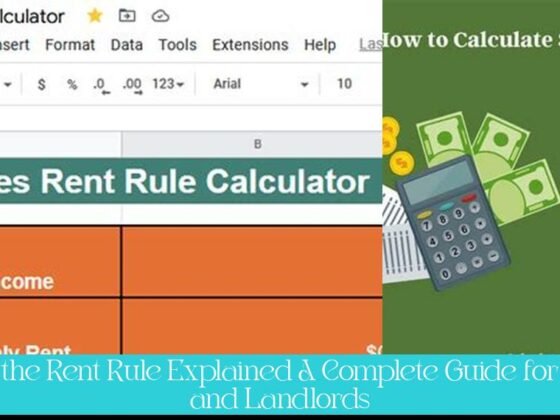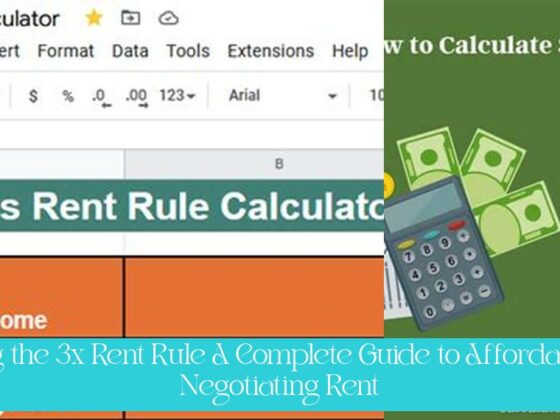Unlocking the door to your dream apartment can sometimes feel like a game of financial acrobatics. But fear not, because we’re here to guide you through the ultimate renting rule: 2.5 times the monthly rent. Whether you’re a seasoned renter or a first-timer, understanding this magic number is the key to landing the perfect place near you. From calculating your gross income to clever tips for meeting the requirement, we’ve got you covered. So, grab a seat and let’s dive into the comprehensive guide for renters who want to crack the 2.5 times monthly rent code.
Key Takeaways
- The 2.5 times rent rule means that a tenant’s gross income should be at least 2.5 times the monthly rent amount.
- Some communities use a 3 times rent calculator formula, requiring a renter’s monthly income to be at least 3 times the rent.
- To meet the 2.5x requirement, a tenant only needs around $14.50 for a $1000 per month apartment, which is less than Portland’s current minimum wage.
- If a tenant doesn’t meet the 3 times rent requirement, they can consider increasing the security deposit, finding a guarantor, or demonstrating financial responsibility to still be able to rent the apartment.
- Landlords often use the 2.5 times the monthly rent as a minimum household income requirement for tenants to qualify for renting a property.
- Apartment communities typically look for an annual income that is 40 times the monthly rent to determine how much rent a tenant can afford.
The 2.5 Times Monthly Rent Rule: A Comprehensive Guide for Renters

As a renter, it’s crucial to understand the financial requirements you need to meet in order to qualify for an apartment. One common guideline used by landlords is the “2.5 times monthly rent” rule. This means that your gross monthly income should be at least 2.5 times the amount of your monthly rent.
Understanding the 2.5 Times Monthly Rent Rule
The 2.5 times monthly rent rule is a standard used by many landlords to assess a potential tenant’s ability to afford the rent. It’s based on the assumption that housing costs should not exceed 25% of a household’s gross income. By setting this guideline, landlords aim to minimize the risk of tenants falling behind on rent payments or facing financial difficulties.
>> Mastering the 2.5 Times Monthly Rent Rule: Your Guide to Meeting and Exceeding It
More updates: Mastering the 2.5 Times Rent Calculator: Your Ultimate Guide to Affordability
Calculating Your Gross Income

To determine if you meet the 2.5 times monthly rent rule, you need to calculate your gross income. This includes all sources of income before taxes and other deductions, such as:
- Wages and salaries
- Self-employment income
- Investment income
- Social Security benefits
- Alimony or child support payments
Exceptions to the Rule
While the 2.5 times monthly rent rule is a common standard, there may be exceptions in certain cases. For example, some communities use a 3 times rent calculator formula, requiring a renter’s monthly income to be at least 3 times the rent. Additionally, landlords may consider other factors when evaluating a potential tenant, such as:
- Credit score
- Rental history
- Stability of employment
- References
Tips for Meeting the 2.5 Times Monthly Rent Rule
If you don’t currently meet the 2.5 times monthly rent rule, there are several steps you can take to improve your chances of qualifying for an apartment:
- Increase your income: Look for ways to earn more money, such as taking on a part-time job or asking for a raise.
- Save for a larger security deposit: Some landlords may be willing to rent to tenants who have a larger security deposit.
- Find a guarantor: A guarantor is someone who agrees to pay your rent if you default. Having a guarantor can make you a more attractive candidate for landlords.
- Demonstrate financial responsibility: Provide your potential landlord with bank statements or other documentation that shows your financial responsibility. This can include proof of on-time rent payments, low credit card balances, and a stable savings account.
Overcoming Obstacles to Renting
Even if you don’t meet the 2.5 times monthly rent rule, there are still ways to overcome obstacles and find an apartment. Here are a few strategies:
Increasing Your Security Deposit
Some landlords may be willing to rent to tenants who have a larger security deposit. This can help to offset the risk of the tenant not being able to afford the rent. The amount of the security deposit will vary depending on the landlord and the property.
Finding a Guarantor
A guarantor is someone who agrees to pay your rent if you default. This can make you a more attractive candidate for landlords, as it provides them with a financial safety net. The guarantor must have good credit and a stable income.
Demonstrating Financial Responsibility
Even if you don’t have a high income or a guarantor, you can still demonstrate financial responsibility to potential landlords. This can include providing bank statements or other documentation that shows:
- On-time rent payments
- Low credit card balances
- A stable savings account
- A history of responsible financial decision-making
By providing this documentation, you can show landlords that you are a responsible individual who is likely to be able to afford the rent.
Conclusion
The 2.5 times monthly rent rule is a common guideline used by landlords to assess a potential tenant’s ability to afford the rent. While it is important to understand this rule, it is not the only factor that landlords consider. By increasing your income, finding a guarantor, or demonstrating financial responsibility, you can overcome obstacles and find an apartment even if you don’t meet the 2.5 times monthly rent rule.
1. What is the 2.5 times monthly rent rule?
The 2.5 times monthly rent rule is a guideline used by landlords to assess a potential tenant’s ability to afford the rent. It means that your gross monthly income should be at least 2.5 times the amount of your monthly rent.
2. How do I calculate if I meet the 2.5 times monthly rent rule?
To calculate if you meet the 2.5 times monthly rent rule, multiply the monthly rent by 2.5. For example, if the monthly rent is $1,000, you should be earning at least $2,500 per month in gross income.
3. Are there exceptions to the 2.5 times monthly rent rule?
Yes, some communities use a 3 times rent calculator formula, requiring a renter’s monthly income to be at least 3 times the rent. Additionally, landlords may consider other factors such as credit score, rental history, and stability of employment.
4. What are some tips for meeting the 2.5 times monthly rent rule?
If you don’t currently meet the 2.5 times monthly rent rule, you can consider increasing your income by taking on a part-time job or asking for a raise. You can also save for a larger security deposit or find a guarantor to improve your chances of qualifying for an apartment.
5. Is 2.5 times rent enough?
While some communities use a 3 times rent calculator formula, it is generally recommended that your income is at least 2.5 times your monthly rent amount to meet the guideline for renting an apartment.
6. What is included in calculating gross income for the 2.5 times monthly rent rule?
When calculating your gross income, include all sources of income before taxes and other deductions, such as wages, self-employment income, investment income, social security benefits, alimony, or child support payments.










